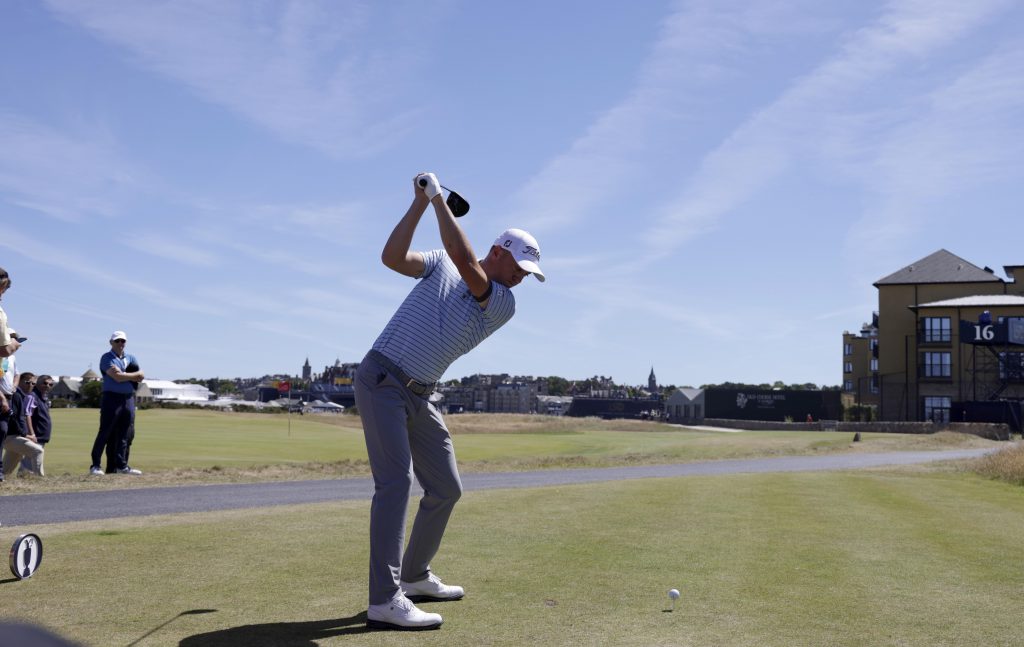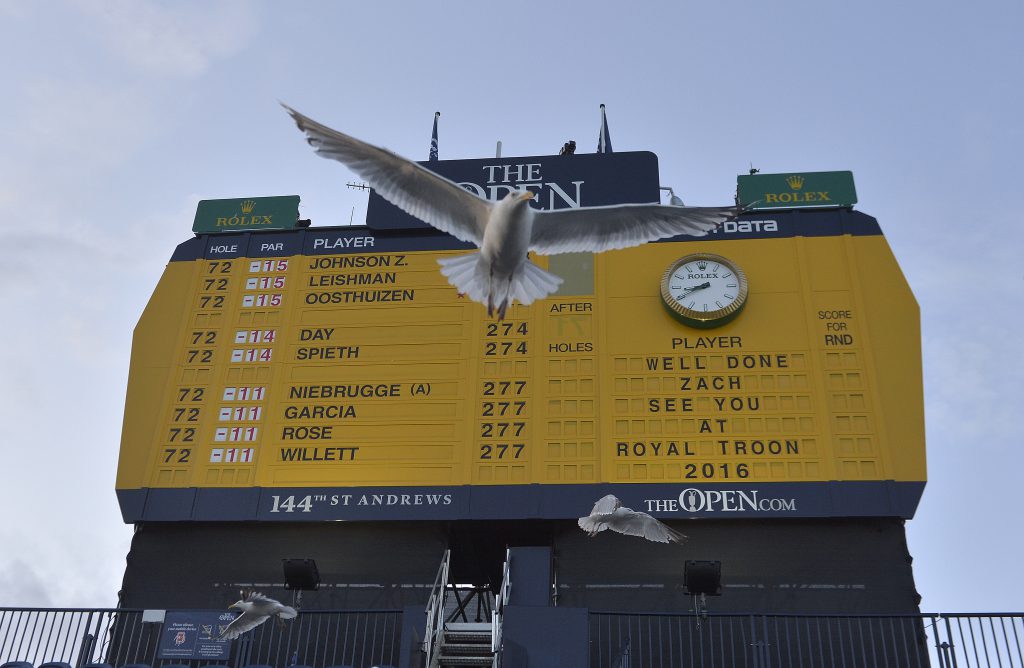1 – Stay out of the bunkers
We all know bunkers at any golf course are classified as hazards, but that fact couldn’t be truer at The Open Championship. The sandy graves at this year’s venue, St Andrews, are about as challenging as they come, and are one of the course’s most significant defences. Given there are 112 around the famous old Links, a thorough gameplan and accurate hitting are an absolute must in order to stay out of them as much as possible. Only two holes – the 1st and 18th – are bunker-free, so there are dangers at virtually every corner around St Andrews and perhaps Tiger Woods’ dominant victory in 2000 typified the importance of avoiding them. The hall of famer and 15-time Major champion didn’t find a single one over the four days on his way to shooting 19-under-par – a full eight shots less than anyone else. He was at his imperious best that week, but the fact he avoided the traps went a long way to guaranteeing him his first Claret Jug. There are many famous bunkers around St Andrews’ Old Course, many of which have decided the fate of countless Opens over the years. This year, the winner will likely be the one who plays best strategically by missing the most perilous traps on the course and therefore limiting the damage that these legendary old hazards can inflict.

2 – The driver isn’t always needed
There’s no doubt that the modern-day golfer hits the ball further than ever before and the majority of courses are very much at the mercy of the world’s longest players. Given the distance the ball goes off the tee these days, most approach shots at most courses are reduced to a short iron or wedge and thus the difficulty of these shots is significantly reduced. Those in the know refer to it as ‘target golf’ and while a plethora of birdies is a great watch for us at home, it certainly won’t be that format this week at St Andrews. Granted, the Old Course isn’t the hardest of The Open Championship’s venues, but there are still plenty of dangers lurking wherever you look and therefore precision and accuracy off the tee is going to be crucial. The warm weather we have seen over the past couple of weeks means St Andrews is going to play firm and fast and thus the ball will run and run on the ground reducing the effectiveness of longer clubs like the driver. This really brings the field together as those who aren’t as powerful off the tee can use the fiery conditions to their advantage. With bunkers, gorse bushes and other hazards in play on virtually every hole, there is much to say for laying the ball well back and avoiding all the danger. It’s likely Tiger Woods will follow this strategy this week and given he used the driver just once on his way to winning the 2006 Open at Hoylake, he’s shown in the past it’s a method that can really pay dividends.

3 – 14 is Long, very long
There are only two par fives around St Andrews, with the first, known as Hole O’Cross, expected to give up plenty of birdies and eagles. But while the world’s best will be confident of picking up at least one shot on that long hole on all four days, the same might not be so true for the other par five, the 14th. Measuring over 600 yards, the 14th begins with a taxing tee shot, where players can choose to go either right or left of a group of bunkers known as the Beardies. With an out-of-bounds wall further to the right, many will likely choose the fairway on the aforementioned fifth hole to the left as the option, although a bold drive to the right, which of course brings the out-of-bounds into play, will be rewarded with a flat lie and a better view of the green. The second shot is then played over the large Hell bunker, which, as the name suggests, is not one you want to find yourself in, or instead players can choose to go along the fifth fairway again on the left. There is loads of sand around the green, and all the bunkers on this hole, known as Long on the scorecard, will be in play depending on wind direction, making this one of the trickier holes played at The Open. So, while this might appear one of the better scoring chances on the back nine, a par on this brute is not a bad result by any means.
4 – 17 is a bumpy road
St Andrews, golf’s most iconic venue, has a number of key holes on its unique layout. For many, though, the hardest is the penultimate 17th, known as the Road Hole. The deviously difficult tee shot sees players drive over the corner of the Old Course Hotel onto a fairway that is very tricky to hold. With trouble all down the right, though, many will bail out left. If that wasn’t hard enough the second shot requires the field to maneuverer their ball away from the Road Hole bunker – one of the deepest on the entire course – which guards the front of the green. The bunker, which has been widened recently, now collects more balls than ever before and that’s unsurprising given there are out-of-bounds markers just a few yards to the right, so a virtually perfect shot is required in order to hit the putting surface. In 2015, Jordan Spieth implied that purposely missing the green was the best way to go, which just shows how demanding a hole it is. It’s almost certain that we’ll see plenty of drama unfold at the par-four over the four days. Given all of this, it’s pretty unsurprising that the last time The Open was played at St Andrews in 2015, the 17th hole was the toughest on the entire PGA Tour that season, playing to a 4.66 scoring average.

5 – The Open: A Major for everyone
For many, The Open is the fairest golf tournament in the world. Yes, the weather can sway it more in favour of one side of the draw, but in terms of the golf courses themselves, there isn’t one type of player that is more suited to them than another, so it’s very much a level playing field. With this in mind, it’s perhaps unsurprising that since Padraig Harrington successfully defended the Claret Jug in 2008 at Royal Birkdale, we’ve seen 13 different Open Championship winners. And you just have to look at those winners to see that all types of players are capable of winning the famous trophy. From the shorter and more precise players like Zach Johnson and Francesco Molinari to the longer hitters like Phil Mickelson and Rory McIlroy, every style of play can go well at an Open if tailored to the specific test that the venue each year presents. Don’t be afraid to look for players that haven’t won a Major yet because as the likes Stewart Cink, Louis Oosthuizen, Darren Clarke, Henrik Stenson, Francesco Molinari and Shane Lowry showed, The Open is certainly a tournament where players can break their Major duck.

6 – Links experience usually crucial
There are, of course, exceptions to the rule, but by and large, Open debutants do not have a good record. Collin Morikawa’s magnificent performance at Royal St George’s last year made him just the fifth player since World War II to win the Claret Jug on his first appearance at The Open and it’s pretty common practice to see those with Open Championship experience challenging for the famous trophy. Morikawa, who also won the PGA Championship on debut, was the first man to achieve the feat since the much lesser-known Ben Curtis was victorious again at Royal St George’s in 2003 and they followed Ben Hogan, Tony Lema and Tom Watson in defying all known trends to emerge victorious on their first try. However, given the paucity of first-time winners of this tournament, it’s pretty clear that playing Links golf time and time again pays dividends with its intricacies and nuances taking plenty of getting used to. You just have to look back to last year’s championship for evidence that debutants struggle with only four of the top 25 making their Open debuts. So, while Morikawa did buck the trend by winning it last year, the numbers suggest that it’s a prudent strategy to stick to those players with Open experience as they are more likely than not going to be ones that are bang there come Sunday afternoon
TO VIEW OUR HUGE ARRAY OF OPEN CHAMPIONSHIP MARKETS – CLICK HERE

Leave a Reply